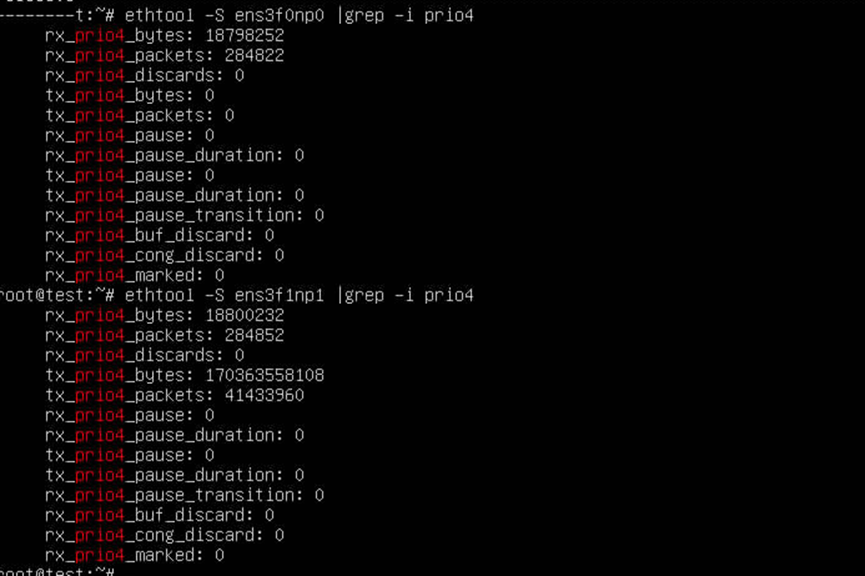本文分享自华为云社区《2个RoCE网卡Bond聚合,实现带宽X2》,作者: tsjsdbd 。
我们知道操作系统里面,可以将2个实际的物理网卡,合体形成一个“逻辑网卡”,从而达到如主备/提升带宽等目的。但是RoCE网卡,是否也跟普通网卡一样,支持Bond能力呢?答案是的,RoCE也可以组Bond,只是比普通网卡多了一些约束。

今天我们就来实际操作一下这个过程,并了解其中需要注意的地方。也欢迎一起交流学习。
根据找到的资料:https://mellanox.my.site.com/mellanoxcommunity/s/article/How-to-Configure-RoCE-over-LAG-ConnectX-4-ConnectX-5-ConnectX-6 里面说的,RoCE网卡的Bond,只支持3种模式:
相比普通网卡总共0-6共七种模式而言,算是打了大折。好在我们想要的“提升带宽”的模式还是有的。
不同的操作系统,执行Bond的命令不一样。这里我实际操作的是Ubuntu22.04,使用自带的 netplan工具,执行bond过程如下:
修改:
vi /etc/netplan/00-installer-config.yaml network: ethernets: ens3f0np0 dhcp4: no ens3f1np1 dhcp4: no version: 2 renderer: networkd bonds: bond0: interfaces: [ens3f0np0, ens3f1np1] parameters: mode: 802.3ad mii-monitor-interval: 1 lacp-rate: faset transmit-hash-policy: layer3+4 addresses: [10.10.2.20/24]复制
执行:
netplan apply复制
后,就可以看到一个叫“bond0”的网卡了。
这里,咱们配置的bond里面有2个重要的参数:
(1)选择bond模式4,即802.3ad(链路聚合)
(2)transmit-hash-policy,负载均衡策略,有以下3种值:

这里由于RDMA点对点通信的时候,IP+MAC地址都不会变。所以咱选 layer3+4,毕竟发送报文的时候,源端口还是随机的。
附CentOS的操作供参考:
新建bond口
nmcli con add type bond ifname tsjbond0 bond.options "mode=2,miimon=100,updelay=100,downdelay=100"复制
添加子网卡
nmcli con add type ethernet ifname enp80s0f0 master tsjbond0 nmcli con add type ethernet ifname enp80s0f1 master tsjbond0复制
激活子网卡
nmcli con up bond-slave-enp80s0f0 nmcli con up bond-slave-enp80s0f1复制
修改了bond卡的配置
vi /etc/sysconfig/network-scripts/ifcfg-bond-tsjbond0 IPADDR=29.28.195.228 NETMASK=255.255.240.0复制
修改2子网卡配置
vi /etc/sysconfig/network-scripts/ifcfg-enp80s0f0 DEVICE=enp80s0f0 TYPE=Ethernet ONBOOT=yes MASTER= tsjbond0 SLAVE=yes BOOTPROTO=none复制
激活bond卡
ifup bond-slave-enp80s0f0 ifup bond-slave-enp80s0f1 ifdown bond-tsjbond0 ifup bond-tsjbond0复制
执行如下命令,首先设置MTU:
ifconfig bond0 mtu 4200复制
然后开启队列4的pfc流控策略:
mlnx_qos -i ens3f0np0 --pfc=0,0,0,0,1,0,0,0 --turst=dscp mlnx_qos -i ens3f1np1 --pfc=0,0,0,0,1,0,0,0 --turst=dscp cma_roce_mode -d mlx5_bond_0 -p 1 -m 2 echo 128 > /sys/class/infiniband/mlx5_bond_0/tc/1/traffic_class复制
其中,前2条命令需要分别为bond下的各个子网卡开启pfc。
然后,mlx5_bond_0 可以通过 ibdev2netdev 命令查询得到。
最后一条echo 128命令,是指强制网卡发送的报文的Traffic Class为128,即匹配网卡发送队列4。不设置的话也行,可以通过 NCCL_IB_TC=128 达成相同的目的。详细可以参考《为什么华为云上AI训练必须设置NCCL_IB_TC=128》一文。
不同的交换机开启LACP模式的命令不一样,这里型号是 CE9860。执行如下:
开启eth-trunk口。
interface Eth-Trunk1 port link-type trunk mode lacp-static复制
然后切换到对应的网口,使其加入到这个trunk口。
interface GigabitEthernet0/0/1 eth-trunk 1 interface GigabitEthernet0/0/2 eth-trunk 1复制
命令操作基本这个思路,另外,LACP的LB策略,是通过修改 load-balance profile default配置完成的:
eth-trunk hash-mode ? INTEGER<1-9> Different hash mode provide different load distribution result for egress traffic flows from a trunk, the default is 1 For Eth-Trunk, mode 1 is suggested For SMAC change, mode 1/2/6/7 is suggested For SIP change, mode 1/5/7/9 is suggested For DIP change, mode 5/6 is suggested For DMAC&SMAC change, mode 9 is suggested For SMAC+SIP change, mode 5/6 is suggested复制
默认值是1。
交换机上执行:
qos buffer headroom-pool size 20164 cells slot 1 interface 400 x/x/x trust dscp dcb pfc enable mode manual dcb pfc buffer 4 xoff dynamic 4 hdrm 3000 cells commit复制
上面的命令,其实除了开启pfc之外,还设置了网口对应的buffer大小。具体参数值大小自己看着办。
这个就是咱们平时经常用的带宽测试命令了:
首先服务器端,启动Server,
ib_write_bw -s 8388608 -F --run_infinitely -x 3 -q 8 --report_gbits
然后Client开始给服务端打流:
ib_write_bw -s 8388608 -F --run_infinitely -x 3 10.10.2.20 -q 8 --report_gbits
其中 -x参数设置为3,是表示使用 RoCE V2协议。
参数 --run_infinitely 可以让测试一直进行而不停止。
-q 表示使用多个QPS(Queue-Pairs)流。对应 NCCL_IB_QPS_PER_CONNECTION,可以尝试设大一点试试效果。
示意的一个结果如下:

查询队列4的报文数量:
watch -n 2 “ethtool -S ens3f0np0 | grep prio4”

这个报文数不会减少,清零不方便,好像重启服务器数量也不会清0。
只找到了通过卸载IB模块来达到清空统计数的目的(假如需要的话):
rmmod mlx5_ib rmmod mlx5_core modprob mlx5_core复制
查询网卡温度:
mget_temp -d mlx5_bond_0
可以看到温度,一般都是62/63度左右。

本文只是操作记录,用于互相交流,不一定是最佳实践,自己有选择的看。
因为官网https://mellanox.my.site.com/mellanoxcommunity/s/article/How-to-Configure-RoCE-over-LAG-ConnectX-4-ConnectX-5-ConnectX-6
这么写的:

我们团队接到了食品频道的一个互动项目的开发需求,希望通过 3D 场景的展示和互动方式,作为对未来购物的一种尝试与探索,满足用户对未来美好新奇的一个需求。将购物场景化、娱乐化,给用户带来美好的购物感受。